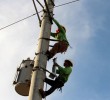By John Rizle L. Saligumba
Davao Today
DAVAO CITY – The campaign to increase renewable energy (RE) production will need “more aggressiveness” on the part of government “or else non-RE sources will just naturally come-in”, the government socio-economic planning unit for Mindanao has said.
Several factors however, are working against encouraging more and bigger RE energy productions in Mindanao, mainly on sourcing of fund to finance bigger projects, and the long permitting process, an officer of a provincial electric cooperative said.
In its presentation of studies on biomass and hydro-electric power plants, the Mindanao Development Authortiy (MinDA) said that current power mix “is 60-40 wherein 60 percent is RE generated from the Agus-Pulangi hydro-electric complex, geothermal, and several small hydro, biomass, and solar plants while the other 40 percent is from fossil fuels such as diesel-powered and coal-fired power plants”.
The most viable RE source for Mindanao is still hydro-power “as eight of the major rivers on the country are in Mindanao”.
MinDA said biomass is also viable energy resource “as Mindanao is an agricultural area (abundant) with (its) agricultural waste.”
“These RE sources also have available baseline data as there are already such plants operating in Mindanao,” it added.
MinDA identified the 15 provinces with higher biomass potential production: Bukidnon, South Cotabato, North Cotabato, Misamis Oriental, Misamis Occidental, Zamboanga del Norte, Compostela Valley, Davao Oriental, Sultan Kudarat, Maguindanao, Zamboanga del Sur, Lanao del Norte, Davao City and Sarangani.
In a press conference, Mr. Bien Tadeo of the First Bukidnon Electric Cooperative (Fibeco), said that biomass energy facilities in various stages of construction can contribute 263.9 megawatts (MW) of electricity to Mindanao’s energy requirement. The Fibeco has invested in biomass energy production,
Tadeo claims that its study on biomass indicates that 20 percent of the “theoretical potential” energy that can be produced with biomass in Mindanao “can reach 795 MW (excluding the 263.9 MW)”.
Fibeco’s biomass plants would need 110,000 metric tons of biomass waste per year in order to operate at full capacity. The Department of Energy Chief Science Research Specialist Andresito F. Ulgado has assured that Fibeco’s research followed the department’s “rule of thumb to ensure that there will be enough supply for the plant to run over the years”.
Funding however, is one of the drawbacks in pushing for more RE ventures, Tadeo said. Tadeo said negotiations with commercial and government banks are still going on and he said the electric cooperative must be able to secure the needed funds by the first semester of this year, anticipating to start commercial operation in 2015.
Fibeco will construct three biomass facilities in Bukidnon, with each facility to cost P1.1 billion and will take 18 months to build.
Montenegro said that often, it has to be the investors who should find sources of funds “as government is not allowed to enter into contracts as stipulated in the Epira [Electric Power Industry Reform Act]”. Montenegro said that Land Bank of the Philippines is one of the partners of Fibeco.
Roderico Bioco, chairperson of the Bukidnon Chamber of Commerce and Industry, said however, that certain provisions in the Epira Law would allow “monopoly” of the country’s energy resources if not revised.
On the issue of complying with documentary requirements, Montenegro said that it would take seven years for RE applications and described it as a “circuitous processes”. He said a One Stop Shop Processing and Facilitation Center (OSPFC) at MinDA and an Internet website to be opened soon, would hope to solve the problem.
Montenegro said they hope to cut short the processing time in half.
“The One Stop Shop will involve 13 government agencies including the local government units,” he said. Montenegro said each agency has its mandated requirement but added that they will try to ask them to keep the time at minimum.
Montenegro mentioned an experience by one company which said that the LGU approval took so long “that the investor lost interest”. He refused to divulge the name of the investor or the location of the project.
Montenegro added that it maybe viable for LGUs to help RE investors with the needed financing and smooth permitting process. For the LGUs, the project will serve as its own embedded power to ensure ready electricity supply.
Meanwhile, Engr. Anastacio Cubos, Jr. of head of the Assessment Team for Hydro Sources of RE company Energias Renovables which conducted a study on the viability hydro-electric plants in Mindanao said they already identified 12 sites where 20 MW plants maybe constructed.
Cubos clarified that these plants are “run-off-the-river” hydro-electric plants which do not require a dam for the impounding of water. Cubos said the constructions of dams are “unwelcomed” to communities.
“These are not like the Sibulan (Davao City) hydro plants [which] are small and depends on the river systems’ height and flow,” said Cubos.
Cubos said these small hydro plants are also different because these have “impounding-like” mechanism like the Sibulan hydro plant which is used in “peaking purposes.” (John Rizle L. Saligumba/davaotoday.com)
davao city, Mindanao, mindanao energy, mindanao power, Philippines\, power crises in mindanao









